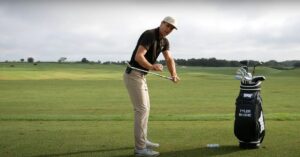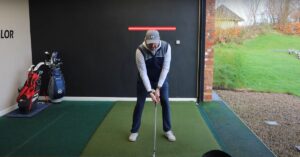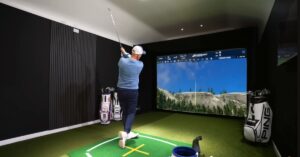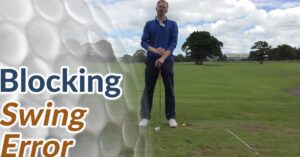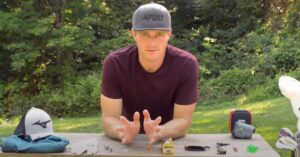How To Fix A Flat Golf Swing: Key Tips And Techniques
If you’re a golfer, you know the importance of having a good swing. A flat golf swing can be a common issue impacting your game. A flat swing occurs when the club is swung too much around the body, resulting in a lack of power and inconsistency.
To fix a flat golf swing, you need to focus on your swing plane and wrist action. Adjusting your swing plane and adding a wrist hinge can create a more powerful and consistent swing.
In this article, we’ll explore some tips and techniques to help you fix your flat golf swing and take your game to the next level.
Common Causes Of A Flat Golf Swing
A flat golf swing can be caused by various factors, including improper body positioning, incorrect grip, lack of rotation, or poor swing mechanics.
Addressing these issues can help improve your swing and enhance your overall golf performance.
Improper Body Positioning
When addressing the ball, if your stance is too wide or too narrow, it can affect your swing plane and make it more likely to become flat.
Additionally, standing too close or too far from the ball can also contribute to a flat swing. Maintaining a balanced and athletic posture is crucial for a proper swing.
Incorrect Grip
The grip is a fundamental aspect of a golf swing, and an improper grip can lead to a flat swing.
If your grip is too weak (hands turned too much to the left for a right-handed golfer), it can cause the clubface to open during the backswing, resulting in a flatter swing plane.
Ensure you have a neutral and secure grip for better control.
Lack Of Rotation
A lack of proper rotation during the swing can cause the club to get stuck behind you, leading to a flat swing.
Insufficient shoulder turn and limited hip rotation prevent you from achieving the necessary depth and arc in your swing, resulting in a flatter plane.
Focus on improving your rotational flexibility and incorporating a full turn for more depth and power.
Poor Swing Mechanics
Flaws in swing mechanics, such as an incorrect takeaway, early extension, or a reverse pivot, can contribute to a flat swing.
These issues can disrupt the proper swing plane and lead to a shallow or flat swing.
Working with a golf instructor or using video analysis can help identify and correct these mechanical flaws.
Lack Of Wrist Hinge
A lack of wrist hinge or improper wrist action can also lead to a flat swing.
Failing to hinge your wrists on the backswing prevents the club from getting into the correct position at the top, resulting in a flat plane on the downswing.
Focus on maintaining proper wrist angles throughout the swing for better club positioning.
how to fix a flat golf swing?
A flat golf swing can lead to inconsistency and a lack of power in your shots. However, you can correct this issue and improve your overall swing with the right adjustments and practice.
This step-by-step guide will help you understand the key adjustments and drills to fix a flat golf swing.
Step 1: Analyze Your Swing Path
To begin, assess your swing path by recording your swing from different angles. Look for a swing that is too flat, where the club is parallel to the ground, or pointing left (for right-handed golfers) during the backswing.
Step 2: Establish A Proper Setup Position
Ensure your setup position is correct by aligning your feet, hips, and shoulders parallel to the target line. Maintain a slight knee flex, bend from the waist, and keep your spine neutral.
Step 3: Focus On The Backswing
During the backswing, work on keeping your lead arm (left arm for right-handed golfers) relatively straight. This will help you maintain a proper swing plane and prevent excessive flattening.
Step 4: Use The Shoulder Turn
Emphasize a full shoulder turn during your backswing. This will help you maintain the correct swing plane and prevent a flat swing. Focus on rotating your lead shoulder under your chin.
Step 5 Incorporate The “Right Elbow” Drill
Practice the “Right Elbow” drill by placing a golf glove or a towel under your right armpit (left armpit for left-handed golfers). This drill will help you maintain a proper arm position and prevent a flat swing.
Step 6: Strengthen Your Core
Developing core strength is crucial for maintaining a consistent swing plane. Incorporate exercises such as planks, Russian twists, and medicine ball rotations into your fitness routine.
Step 7: Seek Professional Guidance
Consider working with a golf instructor or coach who can analyze your swing and provide personalized guidance. They can help identify specific areas for improvement and offer drills tailored to your needs.
Step 8: Practice With Training Aids
Utilize training aids like alignment sticks, impact bags, and weighted clubs to reinforce the correct swing path and plane. These aids can provide feedback and help you develop muscle memory.
Step 9: Film And Evaluate Your Progress
Continuously record your swing to monitor your progress. Compare your swings over time to ensure you maintain the adjustments and gradually improve your swing plane.
Step 10: Regularly Play And Practice
Consistency is key, so make sure to play and practice your golf swing regularly. The more you reinforce the correct adjustments and techniques, the more natural they will become.
Drills And Exercises To Develop A More Vertical Swing Path
Developing a more vertical swing path in golf can enhance your ball-striking consistency and accuracy.
By incorporating specific drills and exercises into your practice routine, you can improve your swing mechanics and achieve better results on the course.
Here are some drills and exercises to help you develop a more vertical swing path
Alignment And Setup
Proper alignment and setup are crucial for a vertical swing path. Use alignment rods or clubs to ensure your feet, hips, and shoulders are aligned parallel to the target line.
Grip And Hand Position
Check your grip and hand position to promote a more upright swing. Maintain a neutral grip and position your hands slightly ahead of the ball at the address.
Tee Drill
Place a tee in the ground about 4-6 inches in front of the ball. Focus on hitting the ball without touching the tee. This drill encourages a steeper approach and prevents a shallow, sweeping swing.
Swing Plane Awareness
Use a mirror or video recording to observe your swing plane. Visualize a steeper swing path and practice swinging along that line. Gradually increase the speed and tempo as you get comfortable.
Impact Bag Drill
Swing through impact while hitting an impact bag or a padded object. Focus on delivering a descending blow to the bag, emphasizing a downward strike instead of a scooping motion.
Resistance Band Training
Attach a resistance band to a stationary object and hold the other end with your lead hand (left hand for right-handed golfers). Mimic the golf swing motion while feeling the resistance, promoting a more vertical path.
Shoulder Turn Drill
Focus on a full shoulder turn during your backswing. This helps create a steeper swing plane and prevents an overly flat or shallow swing.
Practice With Slopes
Utilize uphill or downhill lies to practice a vertical swing. Uphill lies promote a steeper angle of attack, while downhill lies encourage a shallower swing path. Experiment with different slopes to develop adaptability.
Professional Guidance
Consider seeking professional guidance from a golf instructor or coach. They can provide personalized feedback, identify areas of improvement, and prescribe specific drills tailored to your swing.
Frequently Asked Questions
With some simple adjustments and focused practice, you can correct your flat swing and improve your game. Here are some FAQs that will guide you in fixing your flat golf swing
How Can I Improve My Body Rotation?
To enhance body rotation in your swing, focus on turning your shoulders and torso more during the backswing. Engage your core muscles and ensure your hips rotate as well. This increased rotation will help you create a more upright swing plane and generate more power.
What Should I Do With My Arms?
Avoid relying solely on your arms to generate power. Instead, focus on syncing your arm movement with your body rotation. This will promote a more natural and upright swing path. Practice drills that emphasize the proper sequencing of your body and arms to develop muscle memory.
Can My Grip Affect My Swing Plane?
Yes, your grip can influence the swing plane. Check your grip position and ensure it promotes a neutral or slightly stronger grip. Avoid gripping the club too tightly, as it can restrict your wrist movement. A proper grip will allow for a more upright swing plane and help fix a flat swing.
How Can I Practice To Fix My Flat Swing?
To effectively correct a flat swing, practice drills that promote an upright swing plane. Use alignment rods or training aids to guide your swing path. Focus on maintaining proper body rotation and syncing your arms with the rotation. Consistent and deliberate practice will help you develop a more efficient swing.
Conclusion
Fixing a flat golf swing is crucial for improved performance. Focus on proper posture, grip, and rotation to create a more efficient swing.
Regular practice and seeking professional guidance can help you develop a more powerful and accurate swing. Elevate your game with a fixed swing!

